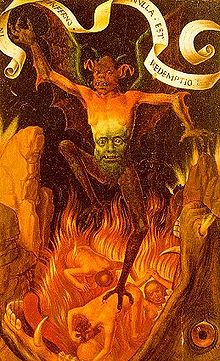Belly face

The belly face (also face the abdomen ; gräzisierend : Gastrocephaler ) is a motif of Christian iconography .
Usually when sinners are punished or saints are tempted, the devil or his subservient male demons are depicted with additional human faces and fabulous grimaces. The predominance of the lower instincts is embodied by this gastrocephalic type of image .
origin
These representations do not originally come from Christian literature, but arose under foreign cultural influences.
Representations
Even in early medieval manuscripts, the head of Medusa is not understood in its demon-warding meaning, but is depicted as a face on the belly in a fantastically funny way. "Belly faces" in Indian mythology have been depicted since the 2nd century. In representations of the Buddha this is attempted by grimacing on the stomach or chest. Representations with faces on the belly can be found on the archivolteen on the south facade in Chartres (13th century).
literature
- Wolfgang Braunfels (Ed.): Lexicon of Christian Iconography . Lim. by Engelbert Kirschbaum, 8 vols. Herder Verlag, Freiburg im Breisgau a. a. 1968-1976. Vol. 2, Col. 140f., ISBN 3-451-22568-9 .
- Jurgis Baltrusaitis: The Fantastic Middle Ages. Ancient and exotic elements of Gothic art . Frankfurt 1985 (first edition: Le Moyen Âge fantastique , Paris 1955).
- E. Castelli: Il demoniaco nell'arte , Milan / Florence 1952
- Howard Daniel: Devils, monsters and nightmares. An introduction to the grotesque and fantastic in art . New York 1964.
- Oswald A. Erich: The depiction of the devil in Christian art . Berlin 1931.
- Wolfgang Menzel: Christian symbolism . Regensburg 1854.